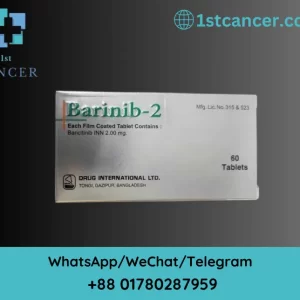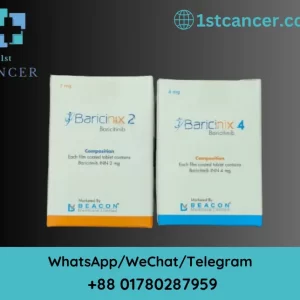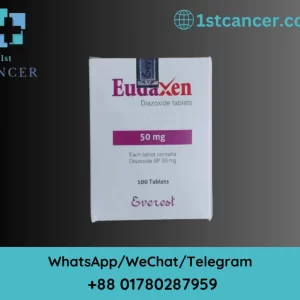In the dynamic realm of hematology, Avatrombopag emerges as a promising player. This belongs to the class of thrombopoietin receptor agonists (TPO-RAs).

This compound, with its distinct mechanism of action and clinical applications. Is shaping the landscape of therapeutic options for conditions marked by thrombocytopenia. This article unfolds the story of Avatrombopag Tablets, delving into its mechanism, clinical uses, ongoing research, and potential side effects. The evolving trends that define its role in modern medicine.
Introduction of Avatrombopag Tablets (Avapag):
In the intricate symphony of hematopoiesis. The quest for effective interventions to address thrombocytopenia has led to the emergence of novel agents, among them. Avatrombopag Tablets stands as a noteworthy protagonist. This belongs to the class of thrombopoietin receptor agonists (TPO-RAs). Avatrombopag offers a targeted approach to managing conditions characterized by insufficient platelet levels. This introduction unravels the story of Avatrombopag, exploring its mechanism of action, and clinical applications. The promise it holds in reshaping the landscape of platelet modulation in various hematologic scenarios.
Understanding Thrombocytopenia:
Thrombocytopenia, a condition characterized by abnormally low platelet levels, poses a significant challenge in clinical hematology. Platelets play a crucial role in hemostasis, and a deficiency in their numbers can lead to bleeding disorders, increased susceptibility to bruising, and compromised clotting mechanisms. Thrombocytopenia can arise from various underlying causes, including chronic liver disease, immune thrombocytopenic purpura (ITP), and chemotherapy-induced suppression of platelet production.
Enter Avatrombopag:
Avatrombopag Tablets, a member of the thrombopoietin receptor agonist family, steps into this narrative with a unique mechanism of action. Its primary goal is to stimulate the production of platelets by engaging with the thrombopoietin receptor. This mimics the natural effects of thrombopoietin. The endogenous regulator of platelet production, and prompts megakaryocytes to mature and release increased numbers of platelets into circulation.
Mechanism of Action Avatrombopag Tablets (Avapag):
At the heart of Avatrombopag’s efficacy lies its ability to navigate the intricate pathways of thrombopoiesis. By interacting with the thrombopoietin receptor, Avatrombopag Tablets promotes the proliferation and maturation of megakaryocytes, the precursors to platelets. This targeted modulation results in a rise in platelet production, addressing the core issue in thrombocytopenic conditions.
Clinical Applications:
The clinical footprint of Avatrombopag Tablets extends to conditions where thrombocytopenia poses a significant clinical challenge. Chronic liver disease, a setting where compromised liver function can impact platelet production, is a key arena for Avatrombopag’s intervention. Additionally, in immune thrombocytopenic purpura, where the immune system targets and destroys platelets, Avatrombopag offers a strategic tool to bolster platelet numbers.
As we delve deeper into the realms of Avatrombopag, subsequent sections will illuminate its journey through clinical trials, potential side effects, and emerging trends that shape its evolving role in the dynamic landscape of hematologic interventions. Avatrombopag Tablets, with its targeted approach to platelet modulation, represents a beacon of hope in the quest to harmonize hematologic harmony in the face of thrombocytopenic challenges.
Background of Avatrombopag Tablets (Avapag):
In the ever-evolving landscape of hematologic therapeutics, Avatrombopag emerges from a rich background rooted in the exploration of thrombopoietin modulation. Understanding the historical context and developmental journey of this thrombopoietin receptor agonist (TPO-RA) sheds light on the rationale behind its creation and the niche it aims to fill in the management of thrombocytopenia. This section delves into the background of Avatrombopag Tablets, unraveling the scientific and clinical threads that have been woven together to bring this promising agent to the forefront of hematologic interventions.
The Thrombopoietin Receptor Agonists (TPO-RAs):
The concept of thrombopoietin receptor agonists, or TPO-RAs, stems from the recognition of thrombopoietin as a pivotal regulator of platelet production. Thrombopoietin, a glycoprotein hormone primarily produced by the liver and kidneys, plays a crucial role in stimulating the production and maturation of megakaryocytes—the precursor cells to platelets. The quest to harness this natural regulatory system and translate it into therapeutic interventions for thrombocytopenic conditions paved the way for the development of TPO-RAs.
The Need for Platelet Modulation:
Thrombocytopenia, characterized by a deficiency of platelets in the bloodstream, presents a spectrum of clinical challenges. Conditions such as chronic liver disease, immune thrombocytopenic purpura (ITP), and chemotherapy-induced thrombocytopenia are marked by compromised platelet production or increased platelet destruction. Addressing these challenges necessitated the development of agents capable of selectively modulating platelet production without compromising safety and efficacy.
Developmental Journey of Avatrombopag:
Avatrombopag Tablets, in the lineage of TPO-RAs, underwent a meticulous developmental journey driven by a profound understanding of thrombopoiesis. The compound was designed to mimic the effects of thrombopoietin by selectively activating the thrombopoietin receptor on megakaryocytes. This activation stimulates the proliferation, maturation, and release of platelets into circulation. Providing a targeted solution for conditions characterized by insufficient platelet levels.
Clinical Precursors and Milestones:
The background of Avatrombopag Tablets is enriched by the milestones achieved by its predecessors in the TPO-RA family, such as romiplostim and eltrombopag. These agents demonstrated the feasibility and efficacy of manipulating thrombopoiesis to raise platelet counts in various clinical scenarios. Avatrombopag, building on this foundation, entered the scene with a refined approach. Aiming for enhanced selectivity and improved pharmacokinetic profiles.
Distinct Characteristics of Avatrombopag:
Avatrombopag’s unique attributes include its high selectivity for the thrombopoietin receptor, oral administration, and a prolonged half-life. These characteristics contribute to its potential as a convenient and effective therapeutic option for individuals grappling with thrombocytopenic conditions.
In summary, the background of Avatrombopag is intricately woven into the fabric of thrombopoiesis research and the evolving landscape of hematologic interventions. We proceed to explore its mechanism of action, clinical applications, and the unfolding trends in its usage. The rich background of Avatrombopag Tablets serves as a foundation for understanding its role in shaping the future of platelet modulation in hematologic care.
Clinical Trials and Research of Avatrombopag Tablets (Avapag):
Avatrombopag, with its distinctive mechanism of action and clinical versatility, is navigating an evolving landscape shaped by ongoing clinical trials and research initiatives. This section delves into the intricate web of studies that seek to unravel the full spectrum of Avatrombopag’s potential applications, efficacy, safety profile, and role in reshaping hematologic interventions.
**1. Clinical Trials in Chronic Liver Disease-Associated Thrombocytopenia:
- Addressing Hepatic Challenges
Clinical trials focused on chronic liver disease (CLD)-associated thrombocytopenia aim to elucidate Avatrombopag’s efficacy in raising platelet counts in individuals with compromised liver function. These studies explore dosing regimens, safety parameters, and the impact of Avatrombopag Tablets on clinical outcomes, providing valuable insights into its role in managing thrombocytopenia in the context of CLD.
**2. Investigations in Immune Thrombocytopenic Purpura (ITP):
- Unraveling Efficacy in Immune-Mediated Conditions
Ongoing research in ITP delves into Avatrombopag’s ability to navigate the complexities of immune-mediated platelet destruction. Clinical trials are designed to assess its effectiveness in raising platelet counts, minimizing bleeding risk, and improving the overall quality of life for individuals with ITP.
**3. Chemotherapy-Induced Thrombocytopenia Trials:
- Optimizing Cancer Treatment Strategies
Clinical trials in chemotherapy-induced thrombocytopenia focus on Avatrombopag’s potential to mitigate hematologic challenges associated with cancer treatment. These studies explore its role in supporting platelet production during chemotherapy, aiming to optimize treatment strategies and enhance the safety and efficacy of cancer therapies.
**4. Pediatric Hematology Explorations:
- Pioneering Applications in Younger Populations
The exploration of Avatrombopag Tablets in pediatric hematology represents a frontier in ongoing research. Early-phase trials aim to evaluate its safety, efficacy, and tolerability in children, potentially paving the way for expanding its applications to younger populations facing thrombocytopenic challenges.
**5. Trials in Myelodysplastic Syndromes and Aplastic Anemia:
- Expanding the Therapeutic Horizon
Beyond its established applications, Avatrombopag Tablets is undergoing investigation in myelodysplastic syndromes and aplastic anemia. These trials aim to unravel its potential role in these diverse hematologic conditions, offering a glimpse into the expanding therapeutic horizon for Avatrombopag.
**6. Dose Optimization Studies:
- Fine-Tuning Therapeutic Approaches
Dose optimization studies play a crucial role in refining the use of Avatrombopag Tablets. These trials explore the most effective and safe dosing regimens, ensuring that Avatrombopag’s impact on platelet production is maximized while minimizing potential side effects.
As Avatrombopag Tablets advances through the currents of clinical trials and research initiatives, its journey is marked by a commitment to precision and innovation in hematologic care. Insights gained from these studies not only shape its current applications but also hold the key to unlocking novel therapeutic avenues. In the subsequent sections, we delve into potential side effects and emerging trends, completing the narrative of Avatrombopag’s role in the dynamic landscape of hematologic interventions.
Potential Side Effects of Avatrombopag Tablets (Avapag):
While Avatrombopag Tablets exhibits promising efficacy in managing thrombocytopenic conditions, like any therapeutic agent, it is not without potential side effects. Understanding and managing these side effects are crucial aspects of ensuring the safe and effective use of Avatrombopag. This section sheds light on the potential side effects associated with Avatrombopag, offering insights into the nuances that clinicians and patients should be vigilant about during its use.
**1. Headache:
- Navigating Common Neurological Symptoms
Headache has been reported as a potential side effect of Avatrombopag Tablets. While the precise mechanism behind this symptom remains under exploration, clinicians should be attentive to patients who may experience headaches during Avatrombopag therapy.
**2. Fatigue:
- Understanding the Impact on Energy Levels
Fatigue is another reported side effect associated with Avatrombopag Tablets. Patients undergoing treatment should be mindful of changes in energy levels and communicate any significant fatigue to their healthcare providers.
**3. Nausea:
- Addressing Gastrointestinal Discomfort
Some individuals may experience nausea as a side effect of Avatrombopag Tablets. This gastrointestinal symptom requires monitoring, and healthcare providers may explore strategies to alleviate nausea or adjust the treatment regimen if necessary.
**4. Elevated Liver Enzymes:
- Balancing Therapeutic Benefits and Hepatic Considerations
Avatrombopag has been associated with elevated liver enzymes in some cases. Regular monitoring of liver function is crucial during Avatrombopag therapy, and clinicians should promptly address any signs of hepatic abnormalities to ensure the ongoing safety of the patient.
**5. Alterations in Lipid Metabolism:
- Exploring Metabolic Impacts
Avatrombopag Tablets may have effects on lipid metabolism, with potential alterations in lipid levels. Clinicians should consider the overall metabolic profile of patients, especially those with pre-existing lipid-related conditions, and monitor lipid levels as part of routine care.
**6. Cataracts:
- Visual Health Considerations
Although less common, the development of cataracts has been reported in association with Avatrombopag Tablets. Patients on long-term therapy may benefit from regular eye examinations to detect and manage potential changes in visual health.
**7. Pruritus:
- Addressing Skin Itching
Pruritus, or skin itching, is another potential side effect of Avatrombopag Tablets. Patients should be aware of any changes in skin sensations and promptly communicate these to their healthcare providers for appropriate management.
**8. Thromboembolic Events:
- Balancing Thrombotic Risks
Thromboembolic events, while rare, are a serious consideration with Avatrombopag Tablets. Clinicians must carefully assess the overall thrombotic risk of patients, especially those with pre-existing cardiovascular conditions, and weigh the potential benefits against the risks before initiating Avatrombopag therapy.
In navigating the potential side effects of Avatrombopag, a collaborative approach between patients and healthcare providers is essential. Vigilant monitoring, open communication, and proactive management strategies contribute to a balanced therapeutic journey, ensuring that the benefits of Avatrombopag Tablets in managing thrombocytopenia are maximized while potential side effects are addressed in a timely and effective manner.
Emerging Trends and Developments of Avatrombopag Tablets (Avapag):
As Avatrombopag continues to carve its niche in the realm of hematologic interventions. Emerging trends, and developments hint at a dynamic future for this thrombopoietin receptor agonist (TPO-RA). This section explores the evolving landscape of Avatrombopag, delving into emerging trends that shape its application, ongoing research directions, and the potential developments that may redefine its role in modern hematologic care.
**1. Combination Therapies and Synergies:
- Exploring Synergistic Approaches
One emerging trend involves the exploration of Avatrombopag in combination with other therapeutic modalities. Researchers are investigating potential synergies with existing treatments for conditions such as chronic liver disease-associated thrombocytopenia and immune thrombocytopenic purpura. This avenue holds promise for enhanced efficacy and a multifaceted approach to thrombocytopenic challenges.
**2. Extended Applications in Myelodysplastic Syndromes:
- Expanding Therapeutic Horizons
Ongoing research is expanding the scope of Avatrombopag to include myelodysplastic syndromes (MDS). The exploration of its potential benefits in MDS, a group of disorders characterized by ineffective blood cell production, represents an exciting frontier. If successful, this expansion could broaden Avatrombopag’s applications to a new spectrum of hematologic conditions.
**3. Personalized Dosing Strategies:
- Tailoring Therapy to Individual Needs
As the field of personalized medicine advances, emerging trends in Avatrombopag research focus on tailoring dosing strategies to individual patient needs. This approach seeks to optimize therapeutic benefits while minimizing potential side effects, acknowledging the heterogeneity of patient responses to treatment.
**4. Pediatric Applications and Pediatric-Specific Formulations:
- Pioneering Pediatric Hematology
The exploration of Avatrombopag in pediatric hematology is a noteworthy trend, with ongoing studies assessing its safety and efficacy in younger populations. Furthermore, the development of pediatric-specific formulations may enhance the convenience and precision of Avatrombopag use in children, addressing a critical gap in pediatric hematologic care.
**5. Long-Term Safety and Efficacy Profiles:
- Building a Foundation of Long-Term Data
As Avatrombopag’s usage extends over longer durations, an emerging trend involves the accumulation of long-term safety and efficacy data. This wealth of information contributes to a comprehensive understanding of Avatrombopag’s performance in real-world scenarios. Guiding clinicians in making informed decisions about its prolonged use.
**6. Advancements in Drug Delivery:
- Enhancing Convenience and Compliance
Ongoing developments in drug delivery systems may further enhance Avatrombopag’s convenience and patient compliance. Formulations that offer extended-release options or alternative routes of administration could contribute to a more patient-friendly experience. Especially in chronic treatment scenarios.
As Avatrombopag embarks on this journey of emerging trends and developments, the evolving landscape holds promise for a more nuanced, effective, and patient-centric approach to hematologic care. These trends not only refine Avatrombopag’s current applications but also open doors to novel therapeutic possibilities. Affirming its position as a pivotal player in the intricate tapestry of hematologic interventions. In the subsequent section. We draw conclusions about Avatrombopag, encapsulating its current standing and envisioning its future trajectory in the dynamic field of hematology.
Conclusion of Avatrombopag Tablets (Avapag):
In the dynamic landscape of hematologic care, Avatrombopag emerges as a promising protagonist. Navigating the intricate pathways of thrombopoiesis with precision and purpose. As we conclude our exploration of Avatrombopag. It becomes evident that this thrombopoietin receptor agonist (TPO-RA) holds significant potential in reshaping the management of thrombocytopenic conditions.
A Targeted Approach to Platelet Modulation:
Avatrombopag’s mechanism of action, is grounded in its selective interaction with the thrombopoietin receptor. Underscores its role as a targeted solution for conditions characterized by insufficient platelet levels. By stimulating megakaryocytes and orchestrating the production of platelets, Avatrombopag addresses the root causes of thrombocytopenia. Offering a nuanced and effective approach to platelet modulation.
Clinical Versatility and Emerging Horizons:
The clinical uses of Avatrombopag span a spectrum of hematologic challenges. From chronic liver disease-associated thrombocytopenia to immune thrombocytopenic purpura and chemotherapy-induced thrombocytopenia. Emerging trends point towards potential applications in myelodysplastic syndromes. Personalized dosing strategies, and pediatric hematology, Avatrombopag’s versatility continues to evolve, paving the way for novel therapeutic horizons.
Balancing Efficacy and Safety:
As with any therapeutic intervention, Avatrombopag is not without potential side effects. Vigilant monitoring and a collaborative approach between patients and healthcare providers are crucial in balancing the therapeutic benefits with potential risks. The evolving understanding of its long-term safety and efficacy profiles contributes to a comprehensive view of Avatrombopag’s role in hematologic care.
A Glimpse into the Future:
Emerging trends and developments in Avatrombopag research hint at a future characterized by synergistic approaches. Extended applications, personalized medicine, and advancements in drug delivery. These trends not only refine its current applications but also position Avatrombopag as a pioneering force in the ongoing evolution of hematologic therapeutics.
In Conclusion:
Avatrombopag, with its precision in platelet modulation, clinical versatility, and ongoing innovations, stands at the forefront of hematologic care. Its journey from mechanism to application reflects a commitment to addressing thrombocytopenic challenges with finesse. As we navigate the chapters of Avatrombopag’s narrative, the pages turn with a sense of anticipation. Envisioning a future where this TPO-RA continues to illuminate the path towards precision, efficacy, and patient-centric care in the intricate realm of hematology.





